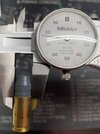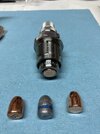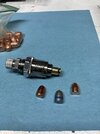JCSC
Member
I am casting and shooting some 230 gr TC bullets, sized to .452. My question and concern relate to flaring, shaving, etc.
I’m shooting mixed brass, so the outside diameter varies slightly around .475/.477”.
I am able to comfortably sit the bullet in the case .062-.080” deep, but I always feel a little resistance when I seat into the second driving band.
Sometimes I see a small sliver, but usually just some extra fine brass powder from the crimp/ flare removal. This usually leaves me around .470 for a finished load.
I’m using a rock chucker and rcbs dies. I’m afraid to use a FCD for fear of swaging the bullets, so seating and crimp in one operation.
I’m concerned about concentricity and leading. Wondering if I should flare more.
Does anyone have any numbers they use for the flare, or perhaps a seating stem that encompasses more of the truncated nose?
I’m shooting mixed brass, so the outside diameter varies slightly around .475/.477”.
I am able to comfortably sit the bullet in the case .062-.080” deep, but I always feel a little resistance when I seat into the second driving band.
Sometimes I see a small sliver, but usually just some extra fine brass powder from the crimp/ flare removal. This usually leaves me around .470 for a finished load.
I’m using a rock chucker and rcbs dies. I’m afraid to use a FCD for fear of swaging the bullets, so seating and crimp in one operation.
I’m concerned about concentricity and leading. Wondering if I should flare more.
Does anyone have any numbers they use for the flare, or perhaps a seating stem that encompasses more of the truncated nose?






